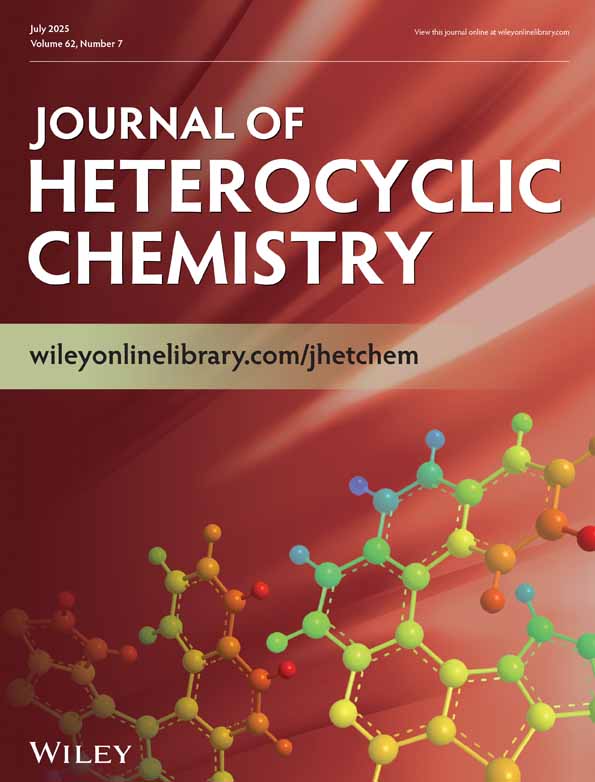1,6- and 1,7-naphthyridines III. 13C-NMR analysis of some hydroxy derivatives
M. Mercedes Blanco
Departamento de Qmímica Orgánica, Facultad de Farmacia y Bioquímica, Universidad de Buenos Aires, Junín 956 (1113), Buenos Aires, Argentina
Search for more papers by this authorGraciela Buldain
Departamento de Qmímica Orgánica, Facultad de Farmacia y Bioquímica, Universidad de Buenos Aires, Junín 956 (1113), Buenos Aires, Argentina
Search for more papers by this authorCelia B. Schapira
Departamento de Qmímica Orgánica, Facultad de Farmacia y Bioquímica, Universidad de Buenos Aires, Junín 956 (1113), Buenos Aires, Argentina
Search for more papers by this authorCorresponding Author
Isabel Perillo
Departamento de Qmímica Orgánica, Facultad de Farmacia y Bioquímica, Universidad de Buenos Aires, Junín 956 (1113), Buenos Aires, Argentina
Departamento de Qmímica Orgánica, Facultad de Farmacia y Bioquímica, Universidad de Buenos Aires, Junín 956 (1113), Buenos Aires, ArgentinaSearch for more papers by this authorM. Mercedes Blanco
Departamento de Qmímica Orgánica, Facultad de Farmacia y Bioquímica, Universidad de Buenos Aires, Junín 956 (1113), Buenos Aires, Argentina
Search for more papers by this authorGraciela Buldain
Departamento de Qmímica Orgánica, Facultad de Farmacia y Bioquímica, Universidad de Buenos Aires, Junín 956 (1113), Buenos Aires, Argentina
Search for more papers by this authorCelia B. Schapira
Departamento de Qmímica Orgánica, Facultad de Farmacia y Bioquímica, Universidad de Buenos Aires, Junín 956 (1113), Buenos Aires, Argentina
Search for more papers by this authorCorresponding Author
Isabel Perillo
Departamento de Qmímica Orgánica, Facultad de Farmacia y Bioquímica, Universidad de Buenos Aires, Junín 956 (1113), Buenos Aires, Argentina
Departamento de Qmímica Orgánica, Facultad de Farmacia y Bioquímica, Universidad de Buenos Aires, Junín 956 (1113), Buenos Aires, ArgentinaSearch for more papers by this authorAbstract
The 13C-NMR spectra of some 1,6-naphthyridines 2 and 1,7-naphthyridines 3, as well as those of N-methyl derivatives 4 and 5, were recorded and analyzed. Results in dimethyl-d6 sulfoxide and deuteriochlo-roform provide useful data on intra and intermolecular hydrogen bonds.
References and Notes
- 1 M. M. Blanco, M. G. Lorenzo, I. A. Perillo and C. B. Schapira, J. Heterocyclic Chem., 33, 361 (1996).
- 2 Rf: ratio front in tlc experiments on Silica gel using chloroform-methanol (9:1) as the solvent.
- 3 M. M. Blanco, I. A. Perillo and C. B. Schapira, J. Heterocyclic Chem., 36, 979 (1999).
- 4 The presence of an intramolecular hydrogen bonding between the enol hydrogen and ester carbonyl, as is evident in 1,7-naphthyridines [3] would avoid this correlation. However, it is well accepted the breaking of such bonds in DMSO-d6 solutions as well as the presence of inter-molecular hydrogen bond between the hydroxyl and the solvent [5,6] (structure B, Scheme V).
- 5 W. Holzer and W. von Philipsborn, Magn. Res. Chem., 27, 511 (1989).
- 6 J. Elguero and A. Martínez, J. Heterocyclic Chem., 27, 865 (1989).
- 7 E. Pretsch, S. Clerc, J. Seibl and W. Simon, Tablas para la Elucidación Estructural de Compuestos Orgánicos por Métodos Espectroscópicos, Springer-Verlag Iberica, Barcelona, 1998.
- 8 G. C. Levy, R. L. Lichter and G. L. Nelson, Carbon-13 Nuclear Magnetic Resonance Spectroscopy, Second Edition, John Wiley and Sons, New York, 1980.
- 9 E. Breitmaier, Structure Elucidation by NMR in Organic Chemistry. A Practical Guide, John Wiley and Sons, Ltd, 1993.
- 10 The 4-hydroxy-1(2H)isoquinolone-3-carboxylic acid ethyl ester (6) [11] was taken as reference. The 13C unequivocal assignments (HMQC and HMBC) are presented below. 13C-NMR (DMSO-d6): δ 164.8 (Ci), 158.2 (Cf), 144.8 (Cg), 132.8 (Cb), 130.8 (Cd), 130.6 (Ca), 129.0 (Ce), 127.3 (Cj), 123.1 (Cc), 108.3 (Ch), 62.1 (CH2) and 13.9 (CH3).
- 11 S. Gabriel and J. Colman, Ber., 33, 980 (1900).
- 12 The solvent influence on the 13C chemical shifts of compounds 2 and 3 could not be study because their slight solubility in deu-teriochloroform.
- 13 Conjugate systems that involve hydrogen bonding between the enol hydrogen and the carbonyl oxygen in related compounds are well known [14-18].
- 14 C. Rossi, A. Casini, M. P. Picchi, F. Laschi, A. Calabria and R. Marcolongo, Biophysical Chemistry, 27, 255 (1987).
- 15 M. M. Blanco, I. A. Perillo, and C. B. Schapira, J. Heterocyclic Chem., 32, 145 (1995).
- 16 C. B. Schapira, M. I. Abasolo and I. A. Perillo, J. Heterocyclic Chem., 22, 577 (1985).
- 17 S. B. Kadin, J. Org. Chem., 34, 3178 (1969).
- 18 C. B. Schapira and I. A. Perillo, J. Heterocyclic Chem., 30, 1051 (1993).
- 19 J. Frigola, J. Heterocyclic Chem., 26, 1373 (1989).
- 20 Structures A and C (Scheme V) as well as mesomeric structures I and V (Scheme III) that contribute to lactame nucleus aromaticity, are responsible for enol stability.




